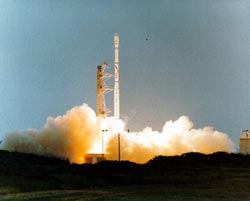|
Stage Separation
 Stage separations between the first and second stages and between the second and third stages were accomplished immediately upon the ignition of the upper stage by means of separation diaphragms. A separation diaphragm was a large thin flat disk of aluminum whose diameter was slightly smaller than the vehicle’s diameter. The outside edge of the disk was threaded. One-half of the threads on the disk mated with internal threads on a structural ring at the bottom of the upper stage structure. The other half of the threads on the disk mated with internal threads on a structural ring at the top of the lower stage structure, thus fastening the two stages together. Radial slots were cut in the diaphragm at its edge so that the diaphragm resembled a flower with a large center and petals. When the upper stage ignited, the pressure from the blast deflected the middle of the diaphragm and broke the petals. The petals fell out of the internal threads in the structural rings, and the stages separated. The early Scout vehicles also used a diaphragm for separating the third and fourth stages, but the large forces involved in breaking the diaphragm could introduce tip-off of the fourth stage at separation and degrade the orbit. It was therefore replaced with the previously described “cold separation” system which used a clamp and explosive bolts. Stage separations between the first and second stages and between the second and third stages were accomplished immediately upon the ignition of the upper stage by means of separation diaphragms. A separation diaphragm was a large thin flat disk of aluminum whose diameter was slightly smaller than the vehicle’s diameter. The outside edge of the disk was threaded. One-half of the threads on the disk mated with internal threads on a structural ring at the bottom of the upper stage structure. The other half of the threads on the disk mated with internal threads on a structural ring at the top of the lower stage structure, thus fastening the two stages together. Radial slots were cut in the diaphragm at its edge so that the diaphragm resembled a flower with a large center and petals. When the upper stage ignited, the pressure from the blast deflected the middle of the diaphragm and broke the petals. The petals fell out of the internal threads in the structural rings, and the stages separated. The early Scout vehicles also used a diaphragm for separating the third and fourth stages, but the large forces involved in breaking the diaphragm could introduce tip-off of the fourth stage at separation and degrade the orbit. It was therefore replaced with the previously described “cold separation” system which used a clamp and explosive bolts.
SCOUT LAUNCH VEHICLE DESCRIPTION
Motors and Structure
Flight Control
Sequencing the Flight Events
Stage Separation
Destruct System and Radar Beacon Command Destruct
Electrical Power
Launch History
Launch List
|